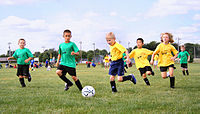
Photo from wikipedia
CONTEXT The risk of experiencing an overuse running-related injury can increase with atypical running biomechanics associated with neuromuscular fatigue and/or training errors. While it is important to understand the changes… Click to show full abstract
CONTEXT The risk of experiencing an overuse running-related injury can increase with atypical running biomechanics associated with neuromuscular fatigue and/or training errors. While it is important to understand the changes in running biomechanics within a fatigue-inducing run, it may be more clinically relevant to assess gait patterns in the days following a marathon to better evaluate the effects of inadequate recovery on injury. OBJECTIVE To use center of mass (CoM) acceleration patterns to investigate changes in running patterns prior to (PRE) and at 2 (POST2) and 7 (POST7) days following a marathon race. DESIGN Pre-post intervention study. SETTING A 200-m oval track surface. PARTICIPANTS Seventeen recreational marathon runners (10 females, age = 34.2 [5.67] y; 7 males, age = 47.41 [15.32] y). INTERVENTION Marathon race. MAIN OUTCOME MEASURES An inertial measurement unit was placed near the CoM to collect triaxial acceleration data during overground running for PRE, POST2, and POST7 sessions. Twenty-two features were extracted from the acceleration waveforms to characterize different aspects of running gait. Lower-limb musculoskeletal pain was also recorded at each session with a visual analog scale. RESULTS At POST2, runners reported higher self-reported pain and exhibited elevated peak mediolateral acceleration with an increased mediolateral ratio of acceleration root mean square compared with PRE. At POST7, pain was reduced and more similar to PRE, with runners demonstrating increased stride regularity in the vertical direction and decreased peak resultant acceleration. CONCLUSIONS The observed changes in CoM motion at POST2 may be associated with atypical running biomechanics that can translate to greater mediolateral impulses, potentially increasing the risk of injury. This study demonstrates the use of an accelerometer as an effective tool to detect atypical CoM motion for runners due to fatigue, recovery, and musculoskeletal pain in real-world environments.
Journal Title: Journal of sport rehabilitation
Year Published: 2019
Link to full text (if available)
Share on Social Media: Sign Up to like & get
recommendations!